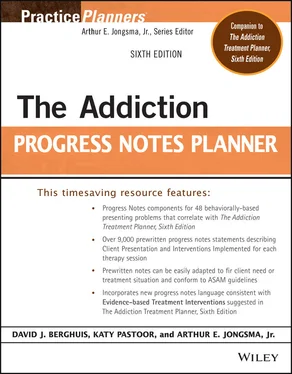The Addiction Progress Notes Planner
Здесь есть возможность читать онлайн «The Addiction Progress Notes Planner» — ознакомительный отрывок электронной книги совершенно бесплатно, а после прочтения отрывка купить полную версию. В некоторых случаях можно слушать аудио, скачать через торрент в формате fb2 и присутствует краткое содержание. Жанр: unrecognised, на английском языке. Описание произведения, (предисловие) а так же отзывы посетителей доступны на портале библиотеки ЛибКат.
- Название:The Addiction Progress Notes Planner
- Автор:
- Жанр:
- Год:неизвестен
- ISBN:нет данных
- Рейтинг книги:5 / 5. Голосов: 1
-
Избранное:Добавить в избранное
- Отзывы:
-
Ваша оценка:
- 100
- 1
- 2
- 3
- 4
- 5
The Addiction Progress Notes Planner: краткое содержание, описание и аннотация
Предлагаем к чтению аннотацию, описание, краткое содержание или предисловие (зависит от того, что написал сам автор книги «The Addiction Progress Notes Planner»). Если вы не нашли необходимую информацию о книге — напишите в комментариях, мы постараемся отыскать её.
The Addiction Progress Notes Planner, Sixth Edition
Addictions Treatment Planner, Sixth Edition
Addiction Treatment Planner, Sixth Edition
The Addiction Progress Notes Planner
The Addiction Progress Notes Planner — читать онлайн ознакомительный отрывок
Ниже представлен текст книги, разбитый по страницам. Система сохранения места последней прочитанной страницы, позволяет с удобством читать онлайн бесплатно книгу «The Addiction Progress Notes Planner», без необходимости каждый раз заново искать на чём Вы остановились. Поставьте закладку, и сможете в любой момент перейти на страницу, на которой закончили чтение.
Интервал:
Закладка:
48 Assist Family Members in Listing Support for Recovery (48)Family members were assisted in identifying ways in which they could be supportive of the client's sobriety.The client reported family members assisting significantly in encouragement and other techniques to help recover from borderline traits and addiction; this validation was emphasized.The client's significant others were strongly encouraged to attend Al-Anon meetings on a regular basis to support recovery.The client reported that family members have not been supportive of recovery; this rejection was processed.
49 Educate the Family About Borderline Syndrome (49)Family members were taught about the client's borderline syndrome and the steps that the client must take to recover successfully.Family members were reinforced as they have displayed an understanding of the client's borderline syndrome and the steps that the client must take to recover successfully.Family members refused to accept the information about the client's borderline syndrome, and they did not display an understanding of the steps that the client must take to recover successfully; remedial feedback was provided.
50 Develop a 5-Year Plan (50)The client was taught about the concept of a 5-year recovery plan.The client was assisted in developing a realistic 5-year personal recovery plan.The client was reinforced for a reasonable 5-year recovery plan.The client was provided with redirection in areas where the recovery plan seemed unrealistic.
51 Assess Satisfaction (51)A treatment satisfaction survey was administered to the client.The client's survey responses indicated a high level of satisfaction with treatment services; these results were processed.The client's survey responses indicated a medium level of satisfaction with treatment services; these results were processed.The client's survey responses indicated a low level of satisfaction with treatment services; these results were processed.Although the client was encouraged to complete a treatment satisfaction survey, it was refused.
NOTES
1 *The numbers in parentheses correlate to the number of the Behavioral Definition statement in the companion chapter with the same title in The Addiction Treatment Planner, Sixth Edition, by Perkinson, Jongsma, & Bruce (Wiley, 2022).
2 *The numbers in parentheses correlate to the number of the Therapeutic Intervention statement in the companion chapter with the same title in The Addiction Treatment Planner, Sixth Edition, by Perkinson, Jongsma, & Bruce (Wiley, 2022).
CHILDHOOD TRAUMA
CLIENT PRESENTATION
1 Physical/Sexual/Emotional Abuse (1) *The client reported having a history of physical/sexual/emotional abuse in childhood.The client reported that painful memories of childhood abusive experiences are intrusive and unsettling.The client reported that nightmares and other disturbing thoughts related to childhood abuse interfere with sleep.The client was able to discuss childhood abusive experiences without being overwhelmed with negative emotions.The client reported that emotional reactions associated with the childhood abusive experiences have been resolved.
2 Addiction Used to Escape Emotional Pain (2)The client reported a pattern of using mood-altering substances to escape emotional pain tied to childhood traumas.As the client has worked through emotional traumas, substance use has decreased.The client reported no longer engaging in any substance use.
3 Neglect Experiences (3)The client reported a history of parents who were neglectful of the client's emotional and physical needs.The client's feelings of low self-esteem, lack of confidence, and vulnerability to depression are related to childhood experiences of neglect.The client stated that their parents were involved with substance abuse and this led to neglect of their child-rearing responsibilities.The client was able to discuss childhood experience of neglect without becoming overwhelmed with negative emotions.
4 Unresolved Psychological Conflicts (4)The client described a pattern of emotional and psychological discord caused by childhood abuse or neglect.The client identified a pattern of interpersonal conflict related to unresolved psychological effects of childhood abuse or neglect.As the client has worked through the pattern of childhood abuse, there have been fewer psychological and relational conflicts.The client reports decreased psychological conflicts and an increased sense of serenity.
5 Irrational Fears (5)The client's early traumatic life experiences have led to continuing irrational fears in the present.As the client has developed insight into conflicts related to childhood, irrational fears have begun to diminish.The client reported a greater sense of security and serenity and an absence of previously held irrational fears.The client reports decreased addiction behavior as irrational fears have decreased.
6 Suppressed Rage (5)The client reported that early painful experiences have resulted in feelings of anger and unexpressed rage.The client has begun to express rage toward their parents for their treatment during childhood.The client's level of anger has diminished, and the client reported a greater sense of peace.As the client's level of anger has diminished, the client has decreased addictive behaviors.
7 Depression and Low Self-Esteem (5)The client reported feelings of low self-esteem and depression related to painful experiences of childhood.As the client has shared pain related to childhood experiences, the feelings of low self-esteem and depression have diminished.The client reported increased feelings of positive self-esteem and a lifting of depression.As the client has progressed in therapy, decreased symptoms of depression and increased self-esteem have resulted in a reduction in addictive behaviors.
8 Identity Conflicts/Anxious Insecurity (5)The client reported struggles with identity and feelings of insecurity because of painful childhood experiences.The client reported a clearer sense of identity and more self-confidence as painful childhood experiences were processed.As the client has processed painful childhood experiences, they have experienced a decrease in addictive behaviors.
9 Intrusive Memories (6)The client described experiencing intrusive, distressing thoughts or images that recall the childhood traumas and their associated intensive emotional response.The client reported a sense of control over the intrusive, distressing thoughts of the traumatic event.The client reported no longer experiencing intrusive, distressing thoughts of the traumatic event.
10 Guilt (6)The client described a pattern of guilty feelings related to a history of childhood trauma.The client reported that as they have worked through the childhood traumas, their sense of guilt has diminished.The client reported no longer experiencing feelings of guilt related to childhood trauma.
11 Emotional Numbing (6)The client reported an inability to experience a full range of emotions.The client reported beginning to be in touch with feelings again.The client is able to experience a full range of emotions.
12 Unresolved Emotions (7)The client described a pattern of unresolved emotional conflict because of a history of childhood trauma.The client described a gradual decrease in unresolved emotional conflict.As the client has worked through the childhood trauma, they described a decreased pattern of unresolved emotional conflict.
13 Maladaptive Behaviors (7)The client described a pattern of maladaptive behaviors to deal with the emotional and psychological conflicts related to the childhood trauma.The client has gained insight into how their maladaptive behaviors are a result of the childhood trauma.The client reported a decreased pattern of maladaptive or unsuccessful behaviors that have resulted from the childhood trauma.
Читать дальшеИнтервал:
Закладка:
Похожие книги на «The Addiction Progress Notes Planner»
Представляем Вашему вниманию похожие книги на «The Addiction Progress Notes Planner» списком для выбора. Мы отобрали схожую по названию и смыслу литературу в надежде предоставить читателям больше вариантов отыскать новые, интересные, ещё непрочитанные произведения.
Обсуждение, отзывы о книге «The Addiction Progress Notes Planner» и просто собственные мнения читателей. Оставьте ваши комментарии, напишите, что Вы думаете о произведении, его смысле или главных героях. Укажите что конкретно понравилось, а что нет, и почему Вы так считаете.












